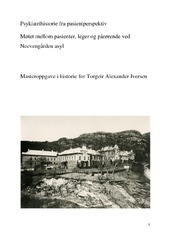Psykiatrihistorie fra pasientperspektiv: Møtet mellom pasienter, leger og pårørende ved Neevengården asyl
Master thesis
Permanent lenke
https://hdl.handle.net/1956/6979Utgivelsesdato
2013-05-15Metadata
Vis full innførselSammendrag
The main focus of this thesis has been to study the interaction between doctors, patients and their next of kin at an asylum in Bergen called Neevengården. My problem question was what was it like being a mental patient at Neevengården between the years 1894-1910? In connection with this was an affimation that the history of psychiatry would look different if patients were given more room. To answer this I used historical sources that included patient journals and correspondence and I wanted to explore what type of information such sources could reveal. In the first part of the thesis I wrote about the context surrounding the history of psychiatry. After that I looked at research within the field as well as ethical considerations. I also took a closer look at the historical sources I used to write this thesis and how they could be used in an historical thesis and what limitations they had. In the second part of my thesis I wrote about the establishment of Neevengården. I had a closer look at the architecture and structure surrounding the institution. In addition I looked at admission to the asylum. Lastly I wrote about the staff at Neevengården. In the remainder of my thesis I used historical sources to answer different aspects regarding the different agents of this historical survey. First and foremost I used different sources to answer questions regarding the patients such as who they were, where they came from (social strata) and what they did at the asylum. I then moved on to look at what the sources could say about the next of kin as well as the chief of medicine at Neevengården. Towards the end of my thesis I endeavored to summarize not only my problem question but also my different themes that I posed early on in this paper. In conclusion I would say that by enabling psychiatric patients a more prominent role this paper has shown that the history of psychiatry has indeed looked different from the voices of the patients. The diversity they have demonstrated has revealed that historical sources from a patient's point of view enable a new understanding of what life was like for asylum patients. In addition letters from next of kin have revealed the complex situation surrounding not only the relationship between the inside and the outside of the asylum but also the different approaches and regards towards insanity in the local community the patients belonged to. Lastly this paper has also demonstrated the important role the chief of medicine had as communication between the inside and the outside of the asylum.
